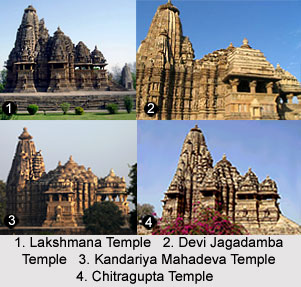 Western Group of temples at Khajuraho includes Kandariya Mahadev Temple, Chaunsat Yogini Temple, Chitragupta Temple, Lakshmana Temple, Matangeswarar Temple Devi jagdamba Temple, Devi Mandap, Varaha Mandap and Mahadeva temple. They are briefly described below:
Western Group of temples at Khajuraho includes Kandariya Mahadev Temple, Chaunsat Yogini Temple, Chitragupta Temple, Lakshmana Temple, Matangeswarar Temple Devi jagdamba Temple, Devi Mandap, Varaha Mandap and Mahadeva temple. They are briefly described below:
Devi Mandap: There are two large shrines opposite the Lakshmana temple It now contains an image of the goddess Brahmani, but originally it housed Vishnu`s mount Garuda, the solar bird.
Varaha Mandap: This open pavilion stands to the south of the Devi shrine on a high platform. It supports the high pyramidal roof capped with an amalaka and kalash.
Lakshmana Temple: This is a five-shrined or panchayatana complex and stands in the centre of a high platform along with its four subsidiary shrines in the corners. Parvati Temple.
Kandariya Mahadeva Temple: One of the greatest monuments in India this cave-like temple gets its name from the word kandara (cave). This is the tallest temple at Khajuraho; with a height of 30.5 m. King Vidyadhara possibly built it, in about AD 1030, after his successful combat with Mahmud of Ghazni.
Mahadeva Temple: On the same platform as the Kandariya Mahadeva, towards its north, lies this partially preserved structure, now called Mahadeva. A favourite theme in Chandella and other Rajput art, a sculpture of a Lion and Warrior, is housed here.
Devi Jagadamba Temple: This temple, to the north of the Kandariya Mahadeva and on the same platform, was originally dedicated to Vishnu and was built in the age having a time gap of 1000-1025 AD. This is deduced from the central image of this god on the door header of its sanctum. However, the temple now enshrines an image of the Devi (Goddess), who is worshipped by the local people on festive occasions. In the mid nineteenth century, the Maharaja of Chhatarpur added a Yajna Kunda, meant for performing rituals. The temple is known for the graceful figure sculptures of mithunas, apsaras, vyalas, and images of deities on its exterior wall.
Chitragupta temple: The only temple dedicated to the sun god on this site, the Chitragupta temple was built somewhat around AD 1000-1025.
Matangeswarar Temple: Matangeshwar temple is a ninth century temple. Chandra dev of the Chandela dynasty built the temple. The king was a devotee of Lord Shiva. Lord Shiva is considered as the venerated sage Matang and that`s how the name of the Shiva Lingam was Matangeswarar.
Chausath Yogini Temple: Towards the southwest of the Shivsagar tank, this temple is located. It was dedicated to the sixty-four Yoginis, believed to be manifestations of the Great Goddess.





















